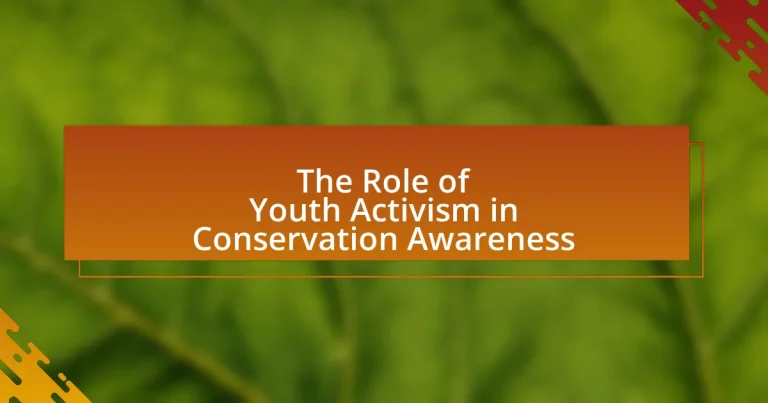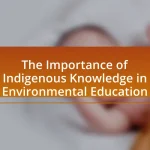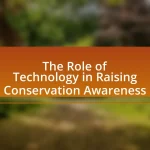Youth activism plays a vital role in raising conservation awareness by mobilizing young individuals to advocate for environmental protection and sustainability. This article explores how youth-led movements, often amplified through social media, effectively influence public perception and policy regarding critical conservation issues such as climate change and biodiversity loss. It highlights specific actions taken by young activists, the challenges they face, and the importance of education and community support in enhancing their efforts. Additionally, the article discusses best practices for engaging peers in conservation initiatives and the potential impact of strategic partnerships in strengthening youth activism.
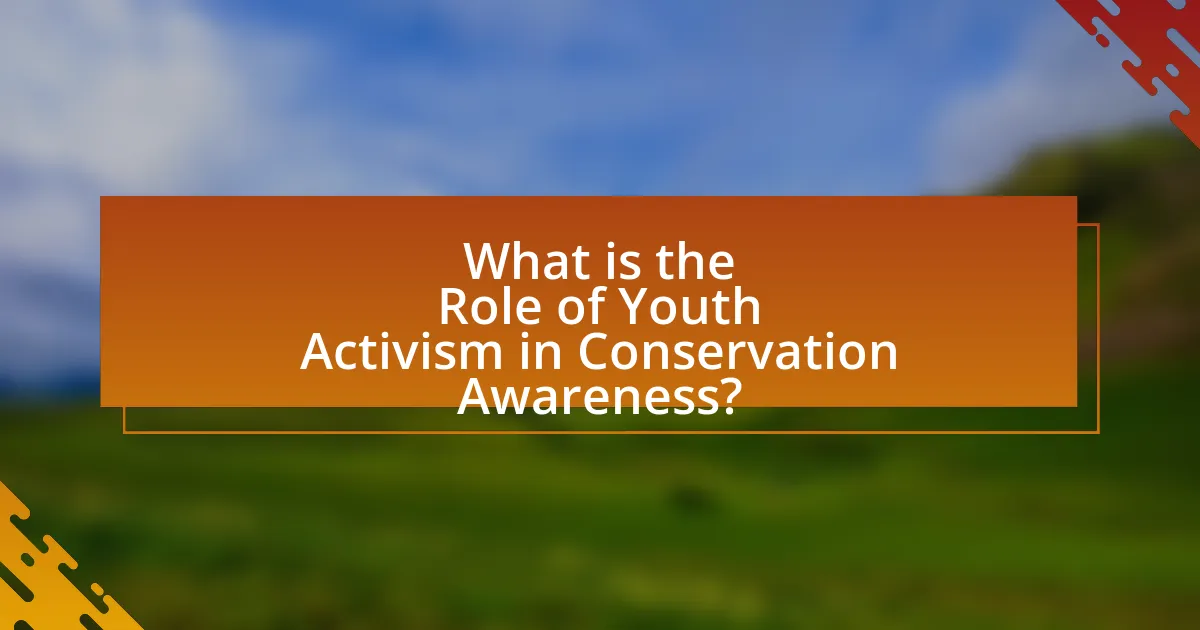
What is the Role of Youth Activism in Conservation Awareness?
Youth activism plays a crucial role in conservation awareness by mobilizing young individuals to advocate for environmental protection and sustainability. This demographic often utilizes social media platforms to raise awareness, organize campaigns, and influence public opinion on critical conservation issues. For instance, the global climate strikes initiated by youth activists like Greta Thunberg have significantly increased public discourse on climate change and conservation efforts, leading to greater engagement from policymakers and communities. Research indicates that youth-led movements can effectively shift societal norms and encourage collective action, as seen in the rise of initiatives aimed at reducing plastic waste and promoting biodiversity.
How does youth activism contribute to conservation efforts?
Youth activism significantly contributes to conservation efforts by mobilizing communities, raising awareness, and influencing policy changes. Young activists often engage in grassroots campaigns that highlight environmental issues, such as climate change and biodiversity loss, effectively reaching a broader audience through social media platforms. For instance, the global climate strikes initiated by youth activists like Greta Thunberg have galvanized millions to advocate for urgent climate action, leading to increased public discourse and pressure on governments to implement sustainable policies. Additionally, studies show that youth-led initiatives can lead to tangible outcomes, such as the establishment of protected areas and the promotion of sustainable practices within local communities.
What specific actions do youth activists take in conservation?
Youth activists engage in various specific actions in conservation, including organizing community clean-up events, advocating for policy changes, and raising awareness through social media campaigns. For instance, youth-led organizations often mobilize volunteers to participate in local habitat restoration projects, which directly contribute to environmental health. Additionally, they frequently lobby local governments to implement sustainable practices, demonstrating their influence on policy. Research indicates that youth activism has led to significant legislative changes in environmental policies, showcasing the effectiveness of their efforts in conservation.
How do youth-led initiatives raise awareness about conservation issues?
Youth-led initiatives raise awareness about conservation issues by engaging communities through education, advocacy, and grassroots campaigns. These initiatives often utilize social media platforms to disseminate information rapidly, reaching a broader audience. For instance, organizations like Earth Guardians mobilize young activists to lead local projects and campaigns that highlight specific conservation challenges, such as climate change and biodiversity loss. Research indicates that youth involvement in environmental advocacy can significantly influence public perception and policy, as seen in the global impact of movements like Fridays for Future, which has galvanized millions to demand action on climate issues.
Why is youth activism important for conservation awareness?
Youth activism is crucial for conservation awareness because it mobilizes young people to advocate for environmental protection and sustainability. This demographic often possesses innovative ideas and a strong commitment to social justice, which can drive significant change in public perception and policy regarding conservation. For instance, movements led by youth, such as the global climate strikes initiated by Greta Thunberg, have successfully raised awareness about climate change and its impacts, influencing both public discourse and governmental action. Research indicates that youth engagement in environmental issues can lead to increased community involvement and support for conservation initiatives, demonstrating the effectiveness of their activism in fostering a culture of environmental stewardship.
What unique perspectives do young activists bring to conservation?
Young activists bring innovative and diverse perspectives to conservation by integrating technology, social media, and a strong sense of justice into their advocacy efforts. Their familiarity with digital platforms allows them to mobilize support quickly and effectively, as seen in campaigns like the global climate strikes initiated by Greta Thunberg, which engaged millions worldwide. Additionally, young activists often emphasize the importance of inclusivity and intersectionality in environmental issues, recognizing that marginalized communities are disproportionately affected by environmental degradation. This approach is supported by research from the United Nations Environment Programme, which highlights the need for diverse voices in conservation efforts to create equitable solutions.
How does youth activism influence public perception of conservation?
Youth activism significantly influences public perception of conservation by mobilizing communities and raising awareness about environmental issues. Young activists often utilize social media platforms to disseminate information rapidly, engage their peers, and advocate for sustainable practices. For instance, movements like Fridays for Future, initiated by Greta Thunberg, have garnered global attention, leading to increased public discourse on climate change and conservation efforts. Research indicates that youth-led initiatives can shift public attitudes, as seen in a 2020 study published in the journal “Environmental Communication,” which found that youth activism positively correlates with heightened public concern for environmental issues. This demonstrates that the actions and voices of young activists are pivotal in shaping societal views on conservation.
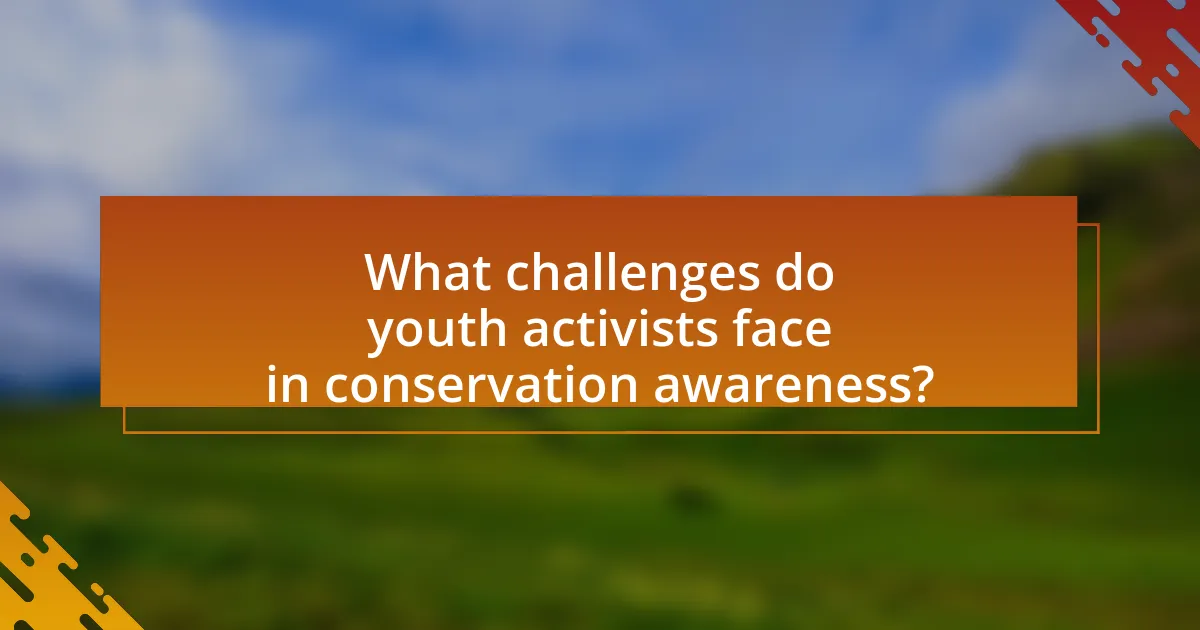
What challenges do youth activists face in conservation awareness?
Youth activists face several challenges in conservation awareness, including limited access to resources, lack of institutional support, and societal skepticism. Limited access to funding and educational materials hampers their ability to effectively promote conservation initiatives. Additionally, many youth activists encounter resistance from established organizations and government bodies that may not prioritize youth involvement. Societal skepticism towards the capabilities and motivations of young activists can further undermine their efforts, as seen in studies indicating that youth-led initiatives often struggle for recognition compared to those led by older, more established figures.
How do societal attitudes impact youth activism in conservation?
Societal attitudes significantly influence youth activism in conservation by shaping the values, motivations, and engagement levels of young activists. Positive societal attitudes towards environmental issues encourage youth to participate in conservation efforts, as seen in movements like Fridays for Future, where widespread support for climate action has mobilized millions of young people globally. Conversely, negative or indifferent societal attitudes can hinder youth involvement, leading to feelings of disillusionment or apathy. Research indicates that when communities prioritize environmental sustainability, youth are more likely to engage in activism, as demonstrated by a study published in the Journal of Environmental Psychology, which found that supportive social norms enhance youth participation in environmental initiatives.
What barriers do young activists encounter in their efforts?
Young activists encounter several barriers in their efforts, including lack of funding, limited access to decision-making processes, and societal pushback. Funding constraints hinder their ability to organize events, conduct research, and promote initiatives effectively. Limited access to decision-making processes often means that their voices are marginalized in discussions that affect environmental policies. Additionally, societal pushback can manifest as criticism or dismissal of their ideas, which can discourage participation and undermine their efforts. These barriers collectively impede the effectiveness of youth activism in conservation awareness.
How can these challenges be overcome?
Youth activism can overcome challenges in conservation awareness through strategic education, community engagement, and leveraging social media platforms. By implementing educational programs that focus on environmental issues, young activists can equip their peers with knowledge and skills necessary for effective advocacy. Community engagement initiatives, such as local clean-up events or tree planting, foster a sense of responsibility and collective action among youth. Furthermore, utilizing social media allows young activists to amplify their messages, reach wider audiences, and mobilize support quickly, as evidenced by campaigns like #FridaysForFuture, which successfully raised global awareness about climate change.
What role does education play in empowering youth activists?
Education plays a crucial role in empowering youth activists by equipping them with knowledge, critical thinking skills, and the ability to engage effectively in social and environmental issues. Through education, young people gain awareness of conservation challenges, understand the importance of biodiversity, and learn about sustainable practices. For instance, studies show that educational programs focused on environmental science significantly increase students’ engagement in conservation efforts, as evidenced by initiatives like the Eco-Schools program, which has led to increased environmental action among participants. This foundational knowledge enables youth activists to advocate for change, mobilize their peers, and influence policy decisions effectively.
How can educational programs enhance conservation awareness among youth?
Educational programs can enhance conservation awareness among youth by providing them with knowledge about environmental issues and fostering a sense of responsibility towards nature. These programs often include hands-on activities, field trips, and interactive learning experiences that engage students directly with their environment. For instance, studies have shown that students who participate in environmental education programs demonstrate increased knowledge of ecological concepts and a greater likelihood of engaging in pro-environmental behaviors. Research conducted by the North American Association for Environmental Education indicates that such programs can lead to a 50% increase in students’ understanding of conservation topics. By integrating conservation education into school curricula, youth are better equipped to advocate for sustainable practices and become active participants in conservation efforts.
What skills do young activists need to effectively promote conservation?
Young activists need strong communication skills to effectively promote conservation. Effective communication allows them to articulate their message clearly, engage diverse audiences, and mobilize support for conservation initiatives. Additionally, critical thinking skills enable them to analyze environmental issues, assess the impact of policies, and develop innovative solutions. Leadership skills are also essential, as they empower young activists to inspire others, organize campaigns, and drive collective action. Furthermore, digital literacy is crucial in today’s technology-driven world, allowing activists to leverage social media and online platforms to raise awareness and reach a broader audience. These skills collectively enhance the effectiveness of young activists in advocating for conservation efforts.
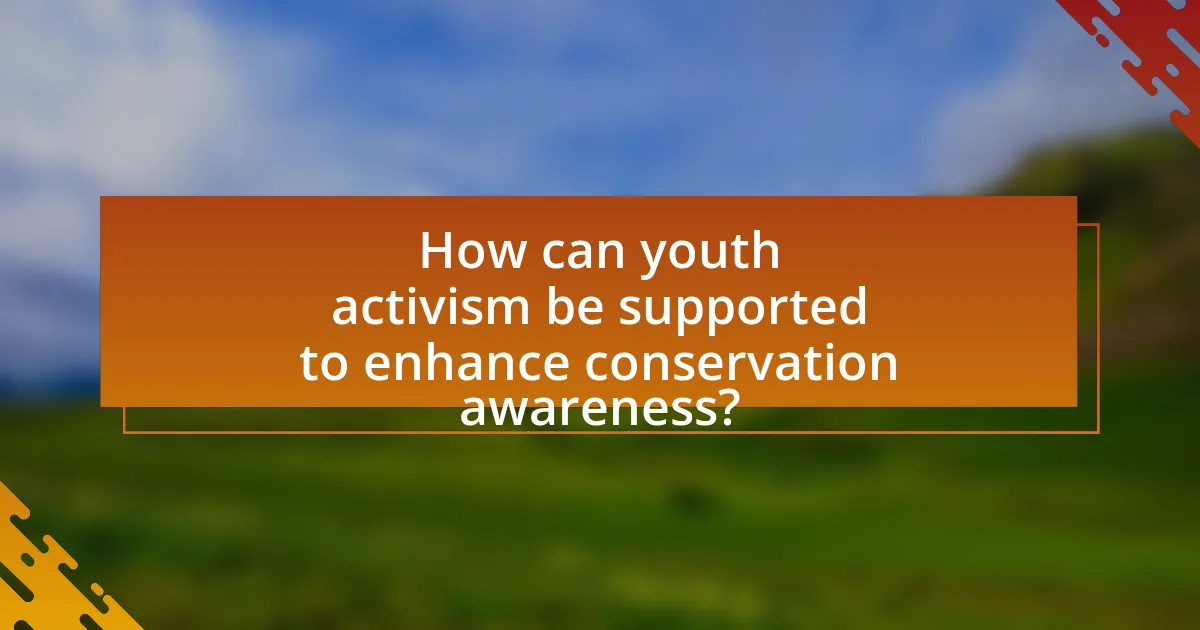
How can youth activism be supported to enhance conservation awareness?
Youth activism can be supported to enhance conservation awareness through targeted educational programs and funding opportunities. Educational initiatives that focus on environmental science and conservation can empower young activists with knowledge and skills, enabling them to effectively advocate for conservation issues. For instance, programs like the Youth Environmental Network provide resources and training for youth-led projects, fostering leadership and engagement in conservation efforts. Additionally, providing grants and financial support for youth-led initiatives can facilitate the implementation of conservation projects, as evidenced by the success of the National Geographic Society’s grants for youth-led conservation efforts, which have resulted in increased community involvement and awareness.
What resources are available for youth activists in conservation?
Youth activists in conservation have access to various resources, including educational programs, funding opportunities, and networking platforms. Organizations such as the World Wildlife Fund (WWF) and Greenpeace provide training and resources tailored for young activists, focusing on skills like advocacy and project management. Additionally, platforms like the Youth Climate Leaders offer mentorship and workshops to enhance leadership abilities. Funding sources, such as the Global Environment Facility, support youth-led conservation projects, enabling activists to implement their initiatives effectively. These resources collectively empower youth to engage in impactful conservation efforts.
How can communities support youth-led conservation initiatives?
Communities can support youth-led conservation initiatives by providing resources, mentorship, and platforms for collaboration. Access to funding and grants enables youth groups to implement their projects effectively, while mentorship from experienced conservationists can guide them in best practices and strategies. Additionally, creating community events or forums allows youth to share their ideas and engage with local stakeholders, fostering a supportive environment. Research shows that youth involvement in conservation can lead to increased community awareness and action, as seen in initiatives like the Youth Climate Summit, which mobilized over 1,000 young activists to advocate for environmental policies.
What partnerships can be formed to strengthen youth activism in conservation?
Partnerships between youth organizations, environmental NGOs, educational institutions, and government agencies can significantly strengthen youth activism in conservation. These collaborations can provide resources, mentorship, and platforms for youth to engage in conservation efforts. For instance, organizations like the World Wildlife Fund (WWF) and local schools can work together to create programs that educate students about biodiversity and conservation practices. Additionally, partnerships with government bodies can facilitate youth participation in policy-making processes, ensuring their voices are heard in environmental legislation. Such collaborations have been shown to enhance the effectiveness of conservation initiatives, as evidenced by programs like the Youth in Nature initiative, which successfully mobilized young people to participate in local conservation projects.
What best practices can youth activists adopt for effective conservation awareness?
Youth activists can adopt several best practices for effective conservation awareness, including leveraging social media, engaging in community education, and collaborating with local organizations. Utilizing social media platforms allows activists to reach a broader audience quickly; for instance, campaigns like #FridaysForFuture have mobilized millions globally, demonstrating the power of digital outreach. Engaging in community education through workshops and events fosters local involvement and awareness, as seen in initiatives where youth-led groups educate peers about local environmental issues. Collaborating with local organizations enhances credibility and resource access, exemplified by partnerships between youth groups and established environmental NGOs, which can amplify their impact and outreach efforts.
How can social media be leveraged for conservation campaigns?
Social media can be leveraged for conservation campaigns by utilizing its vast reach to engage and mobilize audiences around environmental issues. Platforms like Instagram, Twitter, and Facebook allow organizations to share compelling visuals, stories, and data that highlight the urgency of conservation efforts. For instance, the World Wildlife Fund (WWF) effectively uses social media to raise awareness about endangered species, garnering millions of followers and engaging them through interactive content and calls to action. Additionally, social media facilitates grassroots movements, enabling youth activists to organize events, share petitions, and create viral challenges that promote conservation. Research indicates that campaigns that incorporate user-generated content can increase engagement by up to 50%, demonstrating the power of community involvement in driving conservation messages.
What strategies can youth activists use to engage their peers in conservation efforts?
Youth activists can engage their peers in conservation efforts by utilizing social media campaigns, organizing community events, and fostering peer-to-peer education. Social media campaigns allow activists to reach a broad audience quickly, as platforms like Instagram and TikTok have proven effective in spreading awareness about environmental issues; for instance, the #FridaysForFuture movement mobilized millions globally through social media engagement. Organizing community events, such as clean-up drives or tree planting, provides hands-on experiences that can inspire participation and a sense of community responsibility. Additionally, fostering peer-to-peer education through workshops or discussion groups encourages dialogue and empowers individuals to share knowledge about conservation, which has been shown to increase engagement and commitment to environmental causes.
